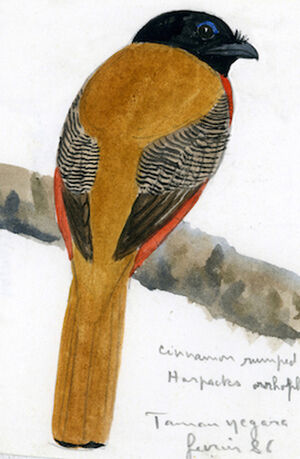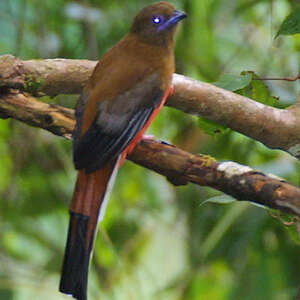Cinnamon-rumped Trogon
Harpactes orrhophaeus - Trogon cannelle
Identification
The Cinnamon-rumped Trogon does not perfume itself with the famous spice, it owes its name to the colouration of its rump, Harpactes orrophaeus, from the Greek Orros which designates the sacrum or rump in ornithological language and Phaios which describes a brown colour. The Anglo-Saxons also gave a poetic name to the colour: Cinnamon-rumped trogon. A symphony of colours and contrasts: measuring 25 cm, the male has a black head, dark brown iris, the eye is surmounted by a perfectly coordinated cobalt-blue eyebrow with a beak extended with a horizontal skin excrescence of the same cobalt-blue. This cobalt trait that divides the black throat from the neck, also black, gives a strange aspect and an almost worrying smile for its prey! The chest is scarlet red while the belly is pale pinkish red, the scapulae, mantle and back are of a cinnamon colour that can pull towards golden yellow depending on the light. The anthracite coverts are vermiculated with very thin white horizontal lines and the remiges have white emarginations that are not always visible. The large central pair of upper rectrices is of the same cinnamon colour as the back and is barred with a black line at its end, from the front the bird shows white lower rectrices which often reveal the two pairs of external upper rectrices black. The Cinnamon-rumped Trogon is very close to Duvaucel's Trogon, with often the same distribution area, they are difficult to distinguish from each other, the Cinnamon-rumped Trogon is substantially larger, the blue mark above the eye is wider and shorter and its beak is stronger, the vermiculations of the Cinnamon-rumped Trogon are less close together than those of Duvaucel's Trogon, they seem more rough; finally Duvaucel's Trogon has a redder belly while the Cinnamon-rumped Trogon has a pink belly, the back is cinnamon for the Cinnamon-rumped Trogon while it turns red for Duvaucel's Trogon.The female has the blue-cobalt bill as well as the blue extension in the back of the bill; the brown iris is surrounded by a very thin blue orbital circle and also shows the same blue mark above the eye. The forehead, cheeks, and throat are brown-rust coloured, while the crown, nape, and parts below the blue projection of the bill's extension are dark brown-grey. The chest and belly are buff, the latter having a slightly yellower hue; the dark brown coverts have much wider buff vermiculations than the male's. The black remiges have white edges. The central rectrices of the upper tail are Cinnamon-rumped Trogon, often showing the black of the outer rectrices, and the lower rectrices are white with greyish-black central parts. The tarses are blue-grey in both sexes. The female Duvaucel Trogon has no brown-rust cheeks, the head and throat are duller, the back is slightly more reddish, the rump is rosier, and the belly more reddish. Juveniles, closer to their mother's colouration, are light brown on the mantle and buff on the chest and belly; the males' vermiculations are coarser, they will get finer with age. Two subspecies are recognized, ssp. orrophaeus orrophaeus in the Thai and Malay Peninsulas, and ssp. vidua in Borneo, which is barely different, the coverts having less vermiculation, the chest less reddish, and more rusty-light; the female is more reddish on the head and the vermiculations are wider.
Subspecific information 2 subspecies
- Harpactes orrhophaeus orrhophaeus (Malay Pen. and Sumatra)
- Harpactes orrhophaeus vidua (Borneo)
Foreign names
- Trogon cannelle,
- Trogón canela,
- republicano-canela,
- Zimtbürzeltrogon,
- Bruinrugtrogon,
- Trogone groppacannella,
- kaneltrogon,
- Kaneltrogon,
- dravčík kapucňový,
- trogon zlatožlutý,
- Okkergumpet Trogon,
- kaneliperätrogoni,
- trogon canyella,
- sędzioł czarnogłowy,
- Коричневогузый азиатский трогон,
- Luntur tunggir-coklat,
- ズグロキヌバネドリ,
- 橙腰咬鹃,
- นกขุนแผนตะโพกสีน้ำตาล,
- 黃棕腰咬鵑,
Voice song and call
Habitat
The Cinnamon-rumped Trogon can be found at very low altitudes in Malaysia and Thailand, mainly in the lower canopy layer. However, in Borneo it has been seen at altitudes up to 1,000-1,400 m in both primary and secondary forests. In Brunei, it has been spotted in Peatswamp forests, very humid forests which lie on beds of decomposing vegetation or near mangroves.
Behaviour character trait
Apparently sedentary.
Dietfeeding habits
His diet seems to be largely insectivorous, a great lover of cicadas (our cicadas), and numerous phasmids of all kinds in its area. It has been observed hunting in small groups.
Reproduction nesting
From March to April until June in the Malay peninsula, and March in Borneo. The nest is dug in an old trunk at a low height (1.5m to 3m). The clutch would be 2 eggs, incubated by the parents, there is very little information and observations on the breeding of the Cinnamon-rumped Trogon.
Geographic range
Threats - protection
IUCN conservation status
concern
in the Wild
threatened
evaluated
Classified as Near Threatened by the IUCN and Birdlife International, our Cinnamon-rumped Trogon was probably protected until recently by its well-concealed habitat. Unfortunately, the rapid population growth and deforestation that this part of Asia is currently facing threatens biodiversity. The species is classified as rare by Birdlife International, it is still considered to be easily observed in Malaysia, and it is becoming increasingly confined to reserves and parks. The future is not looking bright for this exotic trogon, and its classification could quickly move to Vulnerable status: high risk of being endangered!
Sources of information
- IOC World Bird List (v15.1), Gill, F and D Donsker (Eds). 2025-12-07.
- A Natural history of the Trogonidae, Joseph M.Forshaw Albert Earl Gilbert
- Vol. 6 - Handbook of the Birds of the World, Josep del Hoyo-Andrew Elliott-Jordi Sargatal
- Scientific Birds Names, James A.Jobling
- xeno-canto, Sharing bird sounds from around the world,
- Avibase, Lepage Denis
- ARKive, Christopher Parsons
- BirdLife International, BirdLife International
- HBW Alive,
- The internet Bird Collection,
- Wikipédia, Wikipedia, The Free Encyclopedia
Other sources of interest
 Specification sheet created on
04/08/2023 by Anne et Gabriel Leboff
Specification sheet created on
04/08/2023 by Anne et Gabriel LeboffTranslation by AI Oiseaux.net
© 1996-2025 Oiseaux.net
- Accipitriformes
- Aegotheliformes
- Anseriformes
- Apodiformes
- Apterygiformes
- Bucerotiformes
- Caprimulgiformes
- Cariamiformes
- Casuariiformes
- Charadriiformes
- Ciconiiformes
- Coliiformes
- Columbiformes
- Coraciiformes
- Cuculiformes
- Eurypygiformes
- Falconiformes
- Galliformes
- Gaviiformes
- Gruiformes
- Leptosomiformes
- Mesitornithiformes
- Musophagiformes
- Nyctibiiformes
- Opisthocomiformes
- Otidiformes
- Passeriformes
- Pelecaniformes
- Phaethontiformes
- Phoenicopteriformes
- Piciformes
- Podargiformes
- Podicipediformes
- Procellariiformes
- Psittaciformes
- Pterocliformes
- Rheiformes
- Sphenisciformes
- Steatornithiformes
- Strigiformes
- Struthioniformes
- Suliformes
- Tinamiformes
- Trogoniformes




